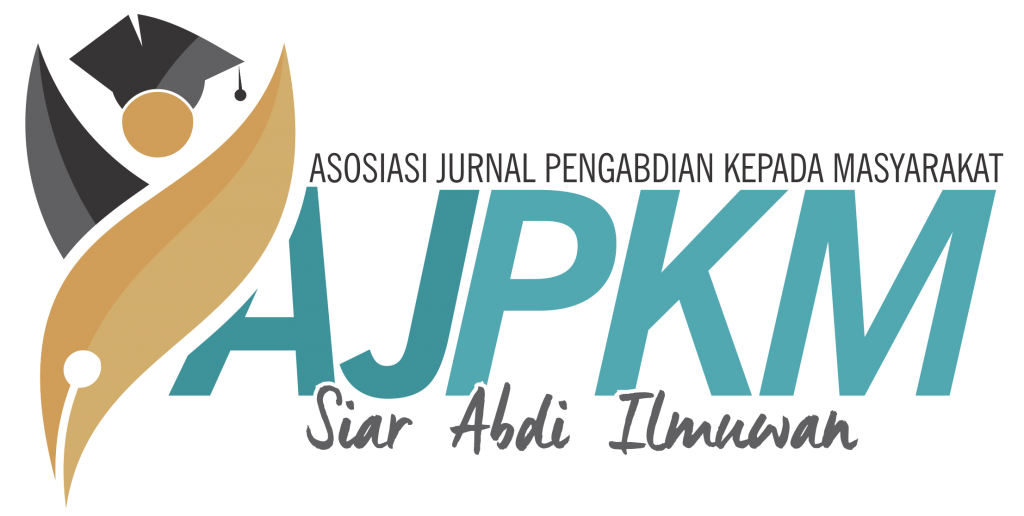Pelatihan Penentuan Status Gizi dan Pengukuran Komposisi Tubuh pada Kader Desa Pantai Raja Kecamatan Perhentian Raja Kabupaten Kampar Provinsi Riau
Abstrak
Status gizi merupakan keadaan yang diakibatkan oleh keseimbangan antara asupan zat gizi dari makanan dengan kebutuhan zat gizi yang diperlukan untuk metabolisme tubuh.. Kegiatan pengabdian ini bertujuan untuk melatih kader desa agar mampu menentukan status gizi dan mengukur komposisi tubuh. Kegiatan pengabdian ini berupa pelatihan penentuan status gizi melalui pelatihan pengukuran IMT, lingkar pinggang (LP) dan menginterprestasikan status gizi menurut IMT berdasarkan standar WHO kriteria Asia Pasifik serta pemeriksaan komposisi tubuh menggunakan bioelectrical impedance analysis (BIA) dan menginterpretasikannya. Pengabdian ini dihadiri 24 peserta.. Terjadi peningkatan keterampilan peserta setelah pelatihan secara signifikan (p<0,001), dimana rerata keterampilan menjadi 88 (50-100) dari yang awalnya rerata 47 (17-67). Kegiatan pengabdian ini bermanfaat meningkatkan keterampilan kader desa dalam menentukan status gizi dan mengukur komposisi tubuh.
Kata Kunci
Teks Lengkap:
PDFReferensi
Abdelaal, M., le Roux, C. W., & Docherty, N. G. (2017). Morbidity and mortality associated with obesity. Annals of Translational Medicine, 5(7), 161.
Amin, F., Fatima, S. S., Islam, N., & Gilani, A. H. (2015). Prevalence of obesity and overweight, its clinical markers and associated factors in a high risk South-Asian population. BMC Obesity, 2(1), 16.
Day, K., Kwok, A., Evans, A., Mata, F., Verdejo-Garcia, A., Hart, K., … Truby, H. (2018). Comparison of a Bioelectrical Impedance Device against the Reference Method Dual Energy X-Ray Absorptiometry and Anthropometry for the Evaluation of Body Composition in Adults. Nutrients, 10(10), 1469.
Dinas Kesehatan Provinsi Riau. (2017). Profil Kesehatan Provinsi Riau Tahun 2016. Pekanbaru: Dinas Kesehatan Provinsi Riau.
Ellulu, M., Abed, Y., Rahmat, A., Ranneh, Y., & Ali, F. (2014). Epidemiology of obesity in developing countries: challenges and prevention. Global Epidemic Obesity, 2(1), 2. https://doi.org/10.7243/2052-5966-2-2
Flegal, K. M., Kit, B. K., Orpana, H., & Graubard, B. I. (2013). Association of all-cause mortality with overweight and obesity using standard body mass index categories: a systematic review and meta-analysis. JAMA, 309(1), 71–82.
Frayling, T. M., Timpson, N. J., Weedon, M. N., Zeggini, E., Freathy, R. M., Lindgren, C. M., … McCarthy, M. I. (2007). A Common Variant in the FTO Gene Is Associated with Body Mass Index and Predisposes to Childhood and Adult Obesity. Science, 316(5826), 889–894.
Gupta, S. R. N. (2014). Body Composition Analysis of Staff members of College Using Bioelectrical Impedance Analysis Method. International Journal of Chemical Engineering and Applications, 5(3), 259–265.
Kalantari, N., Doaei, S., Keshavarz-Mohammadi, N., Gholamalizadeh, M., & Pazan, N. (2016). Review of studies on the fat mass and obesity-associated (FTO) gene interactions with environmental factors affecting on obesity and its impact on lifestyle interventions. ARYA Atherosclerosis, 12(6), 281–290.
Kementerian Kesehatan Republik Indonesia. (2018). Hasil utama riset kesehatan dasar 2018. Kementerian Kesehatan Republik Indonesia. Jakarta: Kementerian Kesehatan Republik Indonesia. Retrieved from https://www.litbang.kemkes.go.id/hasil-utama-riskesdas-2018/
Kotchen, T. A., Grim, C. E., Kotchen, J. M., Krishnaswami, S., Yang, H., Hoffmann, R. G., & McGinley, E. L. (2008). Altered relationship of blood pressure to adiposity in hypertension. American Journal of Hypertension, 21(3), 284–289.
Lim, J. U., Lee, J. H., Kim, J. S., Hwang, Y. Il, Kim, T. H., Lim, S. Y., … Rhee, C. K. (2017). Comparison of World Health Organization and Asia-Pacific body mass index classifications in COPD patients. International Journal of COPD, 12, 2465–2475.
Lu, H. K., Chen, Y. Y., Yeh, C., Chuang, C. L., Chiang, L. M., Lai, C. L., … Hsieh, K. C. (2017). Discrepancies between leg-to-leg bioelectrical Impedance analysis and computerized tomography in abdominal visceral fat measurement. Scientific Reports, 7(1), 1–8.
Marra, M., Sammarco, R., De Lorenzo, A., Iellamo, F., Siervo, M., Pietrobelli, A., … Contaldo, F. (2019). Assessment of Body Composition in Health and Disease Using Bioelectrical Impedance Analysis (BIA) and Dual Energy X-Ray Absorptiometry (DXA): A Critical Overview. Contrast Media & Molecular Imaging, 2019, 1–9.
Merra, G., Gualtieri, P., Cioccoloni, G., Falco, S., Bigioni, G., Tarsitano, M. G., … Di Renzo, L. (2020). FTO rs9939609 influence on adipose tissue localization in the Italian population. European Review for Medical and Pharmacological Sciences, 24(6), 3223–3235.
Mialich, M. S., Maria, J., Sicchieri, F., Afonso, A., & Junior, J. (2014). Analysis of Body Composition : A Critical Review of the Use of Bioelectrical Impedance Analysis. International Journal of Clinical Nutrition, 2(1), 1–10.
Pereira, P. F., Serrano, H. M. S., Carvalho, G. Q., Ribeiro, S. M. R., do Carmo Gouveia Peluzio, M., do Carmo Castro Franceschini, S., & Priore, S. E. (2015). Measurements of body fat distribution: assessment of collinearity with body mass, adiposity and height in female adolescents. Revista Paulista de Pediatria (English Edition), 33(1), 63–71.
Ramírez-Vélez, R., Correa-Bautista, J. E., Martínez-Torres, J., González-Ruíz, K., González-Jiménez, E., Schmidt-RioValle, J., & Garcia-Hermoso, A. (2016). Performance of Two Bioelectrical Impedance Analyses in the Diagnosis of Overweight and Obesity in Children and Adolescents: The FUPRECOL Study. Nutrients, 8(10), 1–13.
Shuster, A., Patlas, M., Pinthus, J. H., & Mourtzakis, M. (2012). The clinical importance of visceral adiposity: a critical review of methods for visceral adipose tissue analysis. The British Journal of Radiology, 85(1009), 1–10. https://doi.org/10.1259/bjr/38447238
Verma, S., & Hussain, M. E. (2017). Obesity and diabetes: An update. Diabetes & Metabolic Syndrome: Clinical Research & Reviews, 11(1), 73–79.
Wang, H., Chen, Y. E., & Eitzman, D. T. (2014). Imaging body fat techniques and cardiometabolic implications. Arteriosclerosis, Thrombosis, and Vascular Biology, 34(10), 2217–2223.
WHO/IASO/IOTF. (2000). The Asia-Pacific Perspective : Redefining Obesity and its treatment. Australia: WHO. Retrieved from https://apps.who.int/iris/bitstream/handle/10665/206936/0957708211_eng.pdf?sequence=1&isAllowed=y
WHO. (2017). Prevalence of obesity among adults. Retrieved March 2, 2021, from http://gamapserver.who.int/gho/interactive_charts/ncd/risk_factors/obesity/atlas.html
WHO. (2020). Obesity and overweight. Retrieved February 28, 2021, from https://www.who.int/news-room/fact-sheets/detail/obesity-and-overweight
WHO Consultation on Obesity. (2000). Obesity: preventing and managing the global epidemic. WHO (Vol. 894).
DOI: https://doi.org/10.24198/dharmakarya.v13i1.42998
Refbacks
- Saat ini tidak ada refbacks.
##submission.license.cc.by4.footer##
Jurnal Ini Terindeks di:








